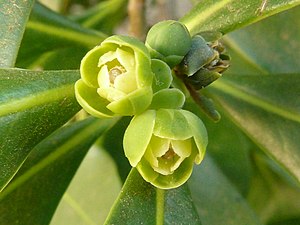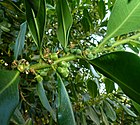Note: This is a project under development. The articles on this wiki are just being initiated and broadly incomplete. You can Help creating new pages.
Warburgia salutaris - Pepper-bark tree
Warburgia salutaris is a species of tree in the Canellaceae family. It is found in Botswana, Namibia, Tanzania, Zambia, Mozambique, South Africa, Swaziland, Malawi and Zimbabwe. It is threatened by habitat loss.
Uses
Malaria, Cold, Chest pain, Cough, Muscle pains, Stomach aches, General body pains, Diarrhea, Sore throats
Parts Used
Chemical Composition
The major oil constituents were myrcene (27.5 %), limonene (16.9 %), and (E)-β-ocimene (11.1 %) and (Z)-β-ocimene (9.5 %) among the monoterpenes, with α-humulene (5.6 %) and β-caryophyllene (4.7 %) among the sesquiterpenes.[1]
Common names
| Language | Common name |
|---|---|
| Kannada | |
| Hindi | |
| Malayalam | |
| Tamil | |
| Telugu | |
| Marathi | NA |
| Gujarathi | NA |
| Punjabi | NA |
| Kashmiri | NA |
| Sanskrit | |
| English | Pepper-bark tree |
Properties
Reference: Dravya - Substance, Rasa - Taste, Guna - Qualities, Veerya - Potency, Vipaka - Post-digesion effect, Karma - Pharmacological activity, Prabhava - Therepeutics.
Dravya
Rasa
Tikta (Bitter), Kashaya (Astringent)
Guna
Laghu (Light), Ruksha (Dry), Tikshna (Sharp)
Veerya
Ushna (Hot)
Vipaka
Katu (Pungent)
Karma
Kapha, Vata
Prabhava
Habit
Identification
Leaf
| Kind | Shape | Feature |
|---|---|---|
| Simple | Alternate | The leaves are simple, elliptic to lanceolate, 4.5-11 x 1-3 cm |
Flower
| Type | Size | Color and composition | Stamen | More information |
|---|---|---|---|---|
| Bisexual | 7–10 mm | Green | 5 | Flowers Season is June - August |
Fruit
| Type | Size | Mass | Appearance | Seeds | More information |
|---|---|---|---|---|---|
| 4 cm | Turning dark purple when ripe | Skin leathery, glandular, black when mature | 2 or more | {{{6}}} |
Other features
List of Ayurvedic medicine in which the herb is used
Where to get the saplings
Mode of Propagation
How to plant/cultivate
A plant of the tropics, where it is found at elevations from 1,000 - 2,200 metres. It grows best in areas where annual daytime temperatures are within the range 5 - 25°c, but can tolerate 10 - 35°[3]
Commonly seen growing in areas
Photo Gallery
References
External Links
- Ayurvedic Herbs known to be helpful to treat Malaria
- Ayurvedic Herbs known to be helpful to treat Cold
- Ayurvedic Herbs known to be helpful to treat Chest pain
- Ayurvedic Herbs known to be helpful to treat Cough
- Ayurvedic Herbs known to be helpful to treat Muscle pains
- Ayurvedic Herbs known to be helpful to treat Stomach aches
- Ayurvedic Herbs known to be helpful to treat General body pains
- Ayurvedic Herbs known to be helpful to treat Diarrhea
- Ayurvedic Herbs known to be helpful to treat Sore throats
- Herbs with Leaves used in medicine
- Herbs with Bark used in medicine
- Herbs with common name in English
- Habit - Evergreen tree
- Index of Plants which can be propagated by Seeds
- Index of Plants which can be propagated by Cuttings
- Herbs that are commonly seen in the region of Savannah woodland
- Herbs that are commonly seen in the region of Coastal forest
- Herbs that are commonly seen in the region of Afromontane forest
- Herbs
- Ayurvedic herbs that don't have flower, fruit and leaf photos
- Ayurvedic herbs that don't have seed photos
- Canellaceae




